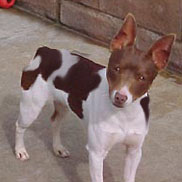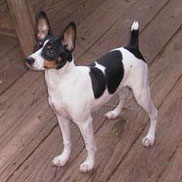Placing a Formula on Your
Dog
How inheritance takes place
Let's take a Chocolate
and White Female knowing what the color of
her parents are: her father is Chocolate and White and her mother is Chocolate,
White and Tan. We breed her to a Tri colored, Black, White and Tan Male
that has a chocolate parent. Using the visual colors, we know that the
Chocolate
and White female carries these genes: (AatbbCCDDEEspsp)
she inherits one gene from each of her parents. Her Chocolate and
White father must be carrying the (A) gene because he does not have
tan markings and similarly the mother was chocolate, white and tan and
so must be carrying the (at) gene in double dose. Her nose is brown
and coat is chocolate so we know she carries the (bb) gene.We know
that the female carries the (C) (D) and (E) gene because
there are no other changes in the dogs coat appearance. We know that the
(sp)
gene is carried because the dog has spots and patches of color.

Choco and White Female
|

Black Tri Male
|
The male
Tri colored dog, Black White Tan carries
these genes: (atatBbCCDDEEspsp).
We know he has to carry the (B) gene because his nose is black.
He also has to have inherited the (b) gene because one of his parents
was chocolate in color. We also know that he has to carry the (at)
gene in double dose because he is a black, white and tan color. We know
that the dog carries the (C) (D) and (E) gene because there
are no other changes in the dogs coat appearance. We know that the (sp)
gene is carried because the dog has spots and patches of color. We will
demonstrate how these two formulas will combine to produce certain colors.
Starting with
The (A Series)
Female Male
A at
at at
The females A
gene combines with the males at
gene = Pup Aat
This produces a Black puppy because the dominant
(A)
gene doesn't allow the tan in the (at) Gene to be seen.
A at
at at
The females at
gene combines with the males at
gene = Pup atat
This produces a Black and Tan puppy
A at
at at
The males at
gene combines with the females A
gene = Pup atA
This produces the same color as the first pup
Black
A at
at at
The males at
gene combines with the females at
gene = Pup atat
This produces the same color as the second pup
Black and Tan
At this point we have 2 black
puppies and 2 black and tan puppies without the addition of the other genes.
The affects of the following genes will serve to add to or modify the affects
of the (A Series) genes.
The B Series
From the formula above we see that the dogs carry
these B series genes.
Female Male
b b
B b
The females b
gene combines with the males b
gene = Pup bb
This combination produces a chocolate dog with
a brown nose
b b
B b
The females b
gene combines with the males B
gene = Pup bB
Because the B is dominant over the b
this combination produces a dog Black with a black nose.
b b
B b
The males b
gene combines with the females b
gene = Pup bb
This makes the pup also chocolate with a brown
nose.
b b
B b
The males B
gene combines with the females b
gene = Pup Bb
This combination makes black with a black nose.
Again the B dominates the b.
When these B genes
combine with the A Series combinations above, (Aat) and (atat)
they can change the appearance of the dog. The (Bb) gene gives the
puppies that inherit it a black coat color and nose. When the (bb)
gene is combined with the A Series it turns the black areas of the
puppies that inherit it chocolate, including the "nose". The black and
tan dog will become chocolate and tan with the (bb) gene.
With the A and B genes combined
we now have the possibility of a black puppy, a chocolate puppy, a black
and tan puppy and a chocolate and tan puppy.
The C Series
The C gene does not need to be combined
because both dogs are carrying the same ones. All puppies produced will
carry (CC). The C gene allows full color to develop
no matter what color the dog is. It will not affect the colors of the dogs
shown above.
The D Series
(DD) controls the density of the color
on the dog and will not change the color of any of the dogs we have produced
in the sample. We do not need to combine the genes because both dogs are
carrying the same and all puppies will carry (DD).
The E Series
The (EE) gene will also not change the
colors of the dogs because it is another gene that allows the pigment to
form to its fullest extent. Again, we do not need to combine the genes
because both dogs are carrying the same gene and all puppies will be (EE)
in formula.
The S Series
The S genes produce varying degrees of
white patterns on the dog's coat. Because the dogs in the example
both carry the same gene we do not need to combine them. All puppies will
carry (spsp). This gene produces the "piebald" pattern
that appears as spots or patches of color. The effects that the (sp)
gene can have on the pups is to leave them with a spots and patches of
color on their body.
Now that all the genes have been combined lets
see what colors of pups we have produced.
Pup AatbbCCDDEEspsp Chocolate
and White with patches of color piebald.
Pup AatbBCCDDEEspsp Black and
White with patches of color
Pup atatbBCCDDEEspsp
Black, White and Tan with patches of color and Tan points
Pup atatbbCCDDEEspsp Chocolate
White and Tan with patches of color and Tan points
There is no longer Black and Tan pups because
the white factor has been added in and they become Tri colored, Black White
Tan.
These are the actual
colors that would be produced in this type of mating but in order for all
the possible combinations to occur in a single litter the mother would
have had to have 16 puppies. Since that is not the usual, all colors that
the parents are able to produce may not appear. A second breeding of the
same pair generally shows all the possibilities. This is how the Mendilian
Theory Works.
|



